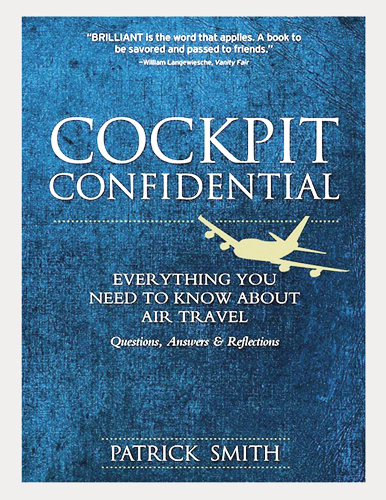The truth about cabin air
Filthy, germ-laden, rotten, disgusting, wretched, skanky, rancid, putrid, fetid, and fart-filled are just a few of the adjectives used to describe cabin air, and legion are the accounts of flyers allegedly made ill by microscopic pathogens circulating throughout a plane. In reality, the air is very clean.
On all modern aircraft, passengers and crew breathe a mixture of fresh and recirculated air. Using this combination rather than fresh air only makes it easier to regulate temperature and helps maintain a bit of humidity (more on the humidity in a moment). The supply is bled from the compressor sections of the engines. Compressed air is very hot, but the compressors only compress; there is no contact with combustion gasses. From there it is plumbed into air conditioning units for cooling. It’s then ducted into the cabin through louvers, vents, and the eyeball gaspers above your seat. The AC units are known to pilots as “packs.” That’s an acronym for pneumatic air cycle kit. Usually there are two per plane.
The air circulates until eventually it is drawn into the lower fuselage, where about half of it is vented overboard—sucked out by the pressurization outflow valve. The remaining portion is remixed with a fresh supply from the engines and run through filters, and the cycle begins again.
Studies have shown that a crowded airplane is no more germ-laden than other enclosed spaces—and usually less. Those underfloor filters are described by manufacturers as being of hospital quality. I needn’t be reminded that hospitals are notorious viral incubators, but Boeing says that between 94 and 99.9 percent of airborne microbes are captured, and there’s a total changeover of air every two or three minutes — far more frequently than occurs in offices, movie theaters, or classrooms.
One persistent urban myth holds that pilots routinely cut back on the volume airflow as a means of saving fuel. It’s especially regrettable when even our most august and reliable news sources parrot this baseless assertion. Case in point: the following is from a 2009 issue of The Economist: “Typically an airline will strike a balance by using a 50:50 mixture of fresh and recirculated air,” says the magazine. “Although pilots can reduce the amount of fresh air to save fuel. Some are thought to cut it back to only 20 percent.” My mouth dropped open when I read this. I love that sentence, “Some are thought to cut it back to only 20 percent,” with its oily overtones of conspiracy.
To start with, pilots cannot tinker with a plane’s air-conditioning systems to modify the ratio of fresh to recirculated air. This ratio is predetermined by the manufacturer and is not adjustable from the cockpit. On the Boeings I fly, we have direct and accurate control over temperature, but only indirect control over flow. If you asked me to please “cut it back to 20 percent,” I would politely inform you that this is impossible. The switches are set to automatic mode prior to flight, and the packs more or less take care of themselves. So long as both engines are turning and everything is operating normally, the flow is perfectly adequate. Only when there’s a malfunction are the settings changed.
I am not as familiar with Airbus models, but let’s talk to somebody who is.
“Airbus series aircraft, from the A320 through the much larger A380, do provide a way for pilots to vary airflow,” says Dave English, an A320 captain and aviation writer. “But not in the way characterized by The Economist.”
English explains that the Airbus controllers have three positions, labeled HI, NORM, and LO. “Almost all the time you’re in the NORM position, and flow control is automatic. The HI position is used when you need a rapid change in temperature. The LO position does as the name implies. It reduces flow and provides some fuel savings, but they are minimal and this isn’t used very often. Company guidance is to use LO whenever the passenger load is below a hundred. It’s not a big change. Sitting in the cabin, it’s almost impossible to notice the difference.”
You’ll occasionally notice a strong odor when the plane is on the ground—a pungent smell similar to the exhaust from an old car or bus that fills the cabin shortly after pushback. Usually this happens when exhaust gases are drawn into the air conditioning packs during engine start. The wind is often to blame, causing air to backflow or blowing fumes through the pack inlets. It normally lasts only a minute or so, until the engine is running and stabilized. It’s unpleasant but little different from the fumes you occasionally breathe in your car while stuck in traffic.
A version of this question, together with dozens more, can be found in the new book!
If passengers have one very legitimate gripe, it’s about dryness. Indeed, the typical cabin is exceptionally dry and dehydrating. At around 12 percent humidity, it is drier than you will find in most deserts. This is chiefly a by-product of cruising at high-altitudes, where moisture content is somewhere between low and nonexistent. Humidifying a cabin would seem a simple and sensible solution, but it’s avoided for different reasons. First, to amply humidify a jetliner would take large quantities of water, which is heavy and therefore expensive to carry. Humidifying systems would need to recapture and recirculate as much water as possible, making them expensive and complicated. They do exist: one sells for more than $100,000 per unit and increases humidity only by a small margin. There’s also the important issue of corrosion. Dampness and condensation leeching into the guts of an airframe can be damaging.
The Boeing 787 has the healthiest air of any commercial plane, thanks to filters with an efficiency of 99.97 percent. Humidity too is substantially higher. The plane’s all-composite structure is less susceptible to condensation, and a unique circulation system pumps dry air through the lining between the cabin walls and exterior skin.
None of this is disputing that people don’t occasionally become unwell from flying. While the air is clean, the dryness is bad for sinuses and can break down mucous barriers, making it easier to catch what bugs might be present. Usually, though, it’s not what passengers are breathing that makes them sick. It’s what they are touching: lavatory door handles, contaminated trays and armrests, etc. A little hand sanitizer is probably a better safeguard than the masks I occasionally see passengers wearing.
Neither am I disputing that the airplane isn’t a potentially exquisite vector for the spread of certain diseases. The benefits of high-speed, long-range air travel are obvious—and so are its dangers. Once after arriving in the United States on a flight from Africa, I noticed a lone mosquito in the cockpit. How easy it would be, I thought, for that tiny stowaway to escape into the terminal and bite somebody. Imagine an unsuspecting airport worker or passenger who has never before left the country, and suddenly he’s in the throes of some exotic tropical malady. Actually, it’s been happening for years. Cases of “airport malaria” have been documented in Europe, resulting in several deaths after faulty or delayed diagnosis. It’s just a matter of time before this happens in America, if it hasn’t already. It is instructive, fascinating, and frankly a little scary to see just how efficiently global air travel can spread pathogens from continent to continent.
And while I’ve got your attention, how about the myth claiming that pilots reduce oxygen levels to keep passengers docile?
This is one of flying’s most enduring fallacies. Not only is it patently false, but it would have a rather undesirable effect on a plane’s occupants: Shortage of oxygen brings on a condition known as hypoxia. Although hypoxia can, at first, make a person feel giddy and relaxed, it also induces confusion, nausea, and migraine-strength headaches. A pilot would have to be pretty sadistic to provoke that kind of mass agony. I remember the multiday hypoxia headache I endured some years ago in Cuzco, Peru—an experience I wouldn’t wish on my worst enemy, let alone a planeload of customers.
Oxygen levels are determined by pressurization, and almost never are the pressurization controls tinkered with during cruise unless there’s a malfunction. Crews set up the system before departure. The rest happens automatically. While en route, the cabin is held at the equivalent of somewhere between 5,000 and 8,000 feet above sea level, depending on aircraft type and cruising altitude.
And pilots are breathing the same air as everybody else. An aircraft fuselage does not contain separate compartments with different pressure values. The entire vessel is pressurized equally from front to back. This includes the cabin, cockpit, and lower-deck cargo holds.





